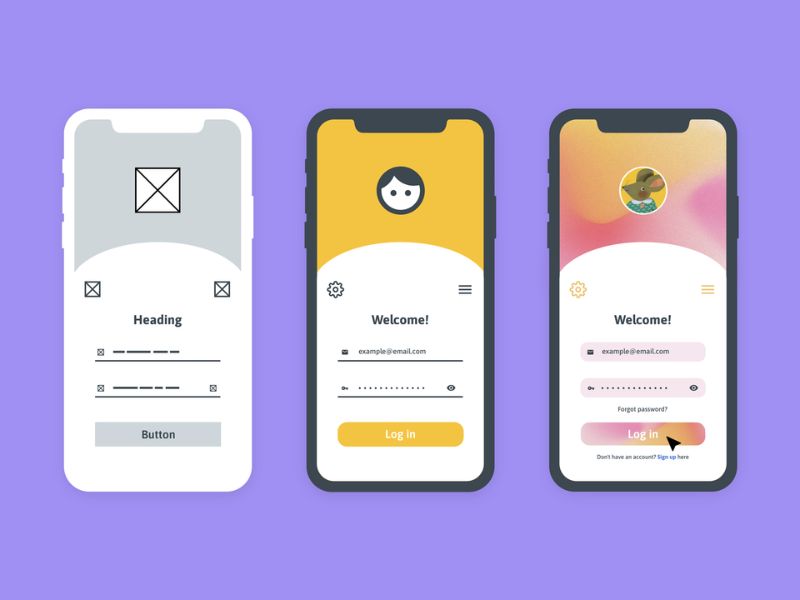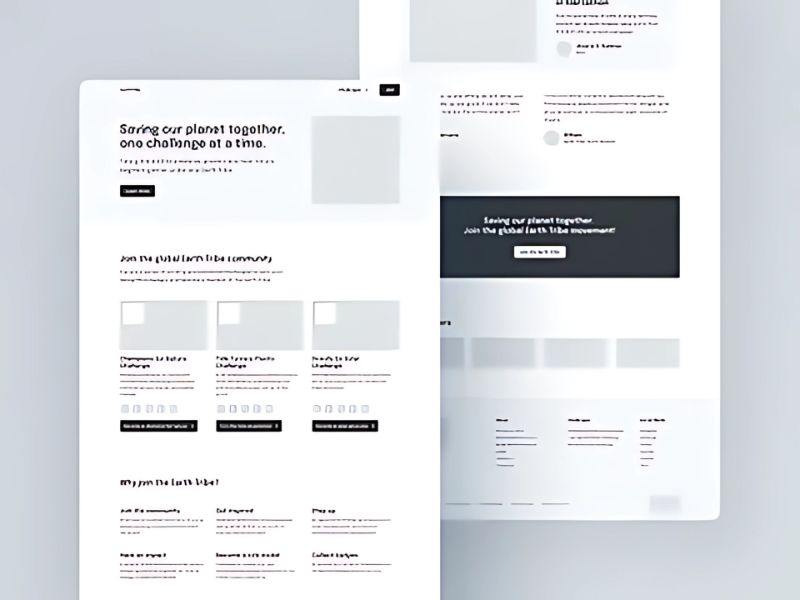Embark on a transformative journey into the world of UI UX design with our comprehensive courses. Whether you’re a budding designer or a seasoned professional looking to upskill, our UI UX design course equips you with the essential knowledge and practical skills to excel in this dynamic field. Gain hands-on experience, build a stellar portfolio, and launch your career in user experience.
Why Choose Online UI UX Design Courses?
Industry-Leading Curriculum
- Online UI UX design courses are meticulously crafted by industry experts who stay abreast of the latest trends and best practices. This ensures that the curriculum is relevant and up-to-date, reflecting the current demands of the UI UX design industry.
- These courses cover a comprehensive range of topics, from the foundational principles of UI and UX design to advanced techniques. This allows students to gain a holistic understanding of the field and develop a well-rounded skill set.
- The curriculum is designed to give the students the most up-to-date information possible.
Hands-On Learning Experience
- Online UI UX design courses provide practical experience through real-world projects and assignments. This allows students to apply theoretical knowledge to practical scenarios, enhancing their understanding and skill development.
- Students have the opportunity to build a portfolio that showcases their skills and creativity. This portfolio serves as a valuable asset when seeking employment in the UI UX design field.
- Building a portfolio is one of the most important things a new UI/UX designer can do.
Expert Mentorship and Guidance
- Online UI UX design courses offer access to experienced instructors who provide personalized feedback and support. This allows students to receive guidance tailored to their individual needs and learning styles.
- Students benefit from the instructors’ industry insights and career advice, gaining valuable perspectives on the UI UX design landscape and potential career paths.
- Students can ask questions and get feedback from experts.
Career Advancement Opportunities
- Online UI UX design courses prepare students for in-demand roles in UI UX design by equipping them with the necessary skills and knowledge.
- These courses often facilitate connections with a network of industry professionals and potential employers, providing students with valuable career opportunities.
- The industry is always looking for qualified UI/UX designers.
Flexible Online Learning
- Online UI UX design courses allow students to learn at their own pace, from anywhere in the world. This flexibility caters to individuals with busy schedules or geographical constraints.
- Students can access course materials and resources anytime, anywhere, ensuring that learning is convenient and accessible.
- Online courses often foster a vibrant online community of learners, providing opportunities for collaboration and networking.

What You’ll Learn in Online UI UX Design Courses
UI Design Fundamentals
- Students will learn the principles of visual hierarchy, layout, color theory, typography, and interactive elements, which are essential for creating visually appealing and user-friendly interfaces.
- They will also learn to use industry-standard tools like Adobe XD and Figma, which are widely used in the UI design industry.
- Learning these tools is very important for getting a job.
UX Design Principles and Processes
- Students will gain an understanding of user research, user personas, user journeys, wireframing, and prototyping, which are crucial for creating user-centered designs.
- They will also learn usability testing and iteration techniques, which are essential for evaluating and refining designs based on user feedback.
- User research is vital to good UX design.
Mobile and Web Design
- Students will learn how to design user-friendly interfaces for mobile apps and websites, considering factors such as screen size, interaction patterns, and user behavior.
- They will also learn about responsive design and accessibility considerations, ensuring that designs are usable by a wide range of users.
- Mobile design is very important in today’s mobile-first world.
Portfolio Development
- Students will build a professional portfolio showcasing their UI UX design skills, which is essential for demonstrating their capabilities to potential employers.
- They will receive feedback and guidance on portfolio presentation, ensuring that their portfolio effectively highlights their skills and experience.
- A good portfolio can be the difference between getting a job and not getting a job.

Who Should Enroll in Online UI UX Design Courses?
Aspiring UI UX Designers
- For those looking to break into the field of UI UX design, online courses provide a structured pathway to gain foundational knowledge.
- These courses offer a comprehensive introduction to core principles, industry tools, and practical skills, enabling aspiring designers to build a strong portfolio and confidently pursue entry-level positions.
- This is a great starting point for those who have no experience in this field.
Graphic Designers
- Graphic designers can expand their skill set and enhance their career prospects by transitioning into UI UX design.
- Online courses offer a seamless transition by building upon existing design knowledge and introducing user-centered design principles, interaction design, and usability testing.
- The transition can be very smooth, because graphic designers already have a strong visual background.
Web Developers
- Web developers can enhance their understanding of user experience and create more effective web interfaces by enrolling in online UI UX design courses.
- These courses provide insights into user behavior, information architecture, and interaction design, enabling developers to build user-friendly and engaging websites and applications.
- Adding UI/UX knowledge to a developer’s skill set will make them much more valuable.
Product Managers
- Product managers can gain valuable insights into UI UX design to improve product development processes and create user-centered products.
- Online courses offer an understanding of user research, prototyping, and usability testing, enabling product managers to make informed decisions and collaborate effectively with design teams.
- Understanding the design process will allow product managers to make better products.
Anyone Interested in UI UX
- Online UI UX design courses are accessible to anyone with a passion for design and technology, regardless of their background or experience.
- Whether you’re a student exploring new career paths or an individual seeking to learn a new skill, these courses provide a flexible and convenient way to gain knowledge and expertise in UI UX design.
- This is a great option for people who just want to learn a new skill.

Basic Online UI UX Design Courses
Google UX Design Professional Certificate (Coursera)
This course, developed by Google, provides foundational knowledge in UX design, from user research to prototype design.
Suitable for beginners looking to pursue a career in UX design.
This is a course created by Google employees, that will give students solid building blocks for creating websites for business.
Link: Google UX Design Professional Certificate
Introduction to User Experience Design (Coursera)
This course introduces basic UX design concepts, including user research, interaction design, and usability evaluation.
Suitable for beginners interested in learning about UX design.
This is a free online course, for beginners that was developed by Dr. Rosa I. Arriaga – Georgia Institute of Technology.
Link: Introduction to User Experience Design
UI/UX Design Specialization (Coursera)
This specialization includes smaller courses covering in-depth knowledge of UI and UX design.
Suitable for beginners looking to pursue a career in UI/UX design.
Link: UI/UX Design Specialization
UX Fundamentals (Interaction Design Foundation)
This course introduces the fundamental principles of UX design, including user research, interaction design, and usability evaluation.
Suitable for beginners interested in learning about UX design.
Link: UX Fundamentals
UI Design Patterns for Successful Software (Interaction Design Foundation)
This course focuses on common UI design patterns, helping students create effective user interfaces.
Suitable for beginners interested in learning about UI design.
Link: UI Design Patterns for Successful Software
UX Design Essentials (Udemy)
This course provides basic knowledge of UX design, including user research, prototype design, and usability testing.
Suitable for beginners interested in learning about UX design.
Link: UX Design Essentials (Udemy)
UI Design with Figma (Udemy)
This course teaches how to use Figma for user interface design.
Suitable for beginners who want to learn UI design using Figma.
Link: UI Design with Figma (Udemy)

The Impact of Online UI UX Design Courses on Your Career
Increased Job Opportunities
UI UX design skills are highly sought after across a wide range of industries, including technology, e-commerce, finance, healthcare, and more. This widespread demand translates to a plethora of job opportunities for skilled UI UX designers.
Online UI UX design courses equip you with the necessary skills and knowledge to pursue various roles, such as UI UX designer, product designer, user experience researcher, interaction designer, and information architect.
With the increased number of apps and websites, the demand for UI/UX designers will only increase.
Higher Earning Potential
UI UX designers command competitive salaries due to the specialized nature of their skills and the critical role they play in creating successful digital products.
Investing in an online UI UX design course can significantly boost your earning potential by providing you with the expertise and portfolio needed to secure high-paying positions.
The better your skills, the more money you will make.
Enhanced Career Growth
UI UX design is a rapidly evolving field, driven by technological advancements and changing user expectations. This dynamic nature creates ample opportunities for career advancement.
Online courses provide you with the skills and knowledge to stay ahead of the curve, ensuring that you remain competitive in the job market.
Continuous learning and staying updated with the latest trends are essential for career growth in UI UX design.
The UI/UX field is always changing, so continuous learning is important.

Online UI UX design courses are your gateway to a rewarding career in user experience. With a comprehensive curriculum, hands-on learning experience, expert mentorship, and flexible online learning, you’ll gain the skills and confidence to excel in this dynamic field. Enroll today and transform your career with our UI UX design courses online. Visit Viartisan to learn more and start your journey!





